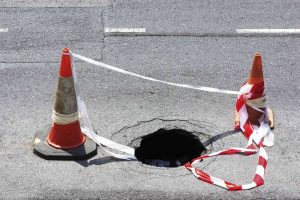Sinkhole and void detection is critical when it comes to protecting the safety of workers and integrity of a construction site, however many people don’t realize that there are differences between the two. What are the differences between sinkholes and voids?
Sinkhole 101
Sinkholes, while appearing to pop up suddenly and cause major damage, develop over a period of years as a result of many different processes. Sinkholes are caused by Karst processes. Karst processes happen when bedrock in the land is soluble. Soluble bedrock is typically made from limestone, dolomite, other carbonate rocks, gypsum, anhydrite, or other evaporitic rocks. Sinkholes happen when there isn’t any external surface drainage, so rain just goes right inside of the sinkhole. Sinkholes can be incredibly tiny or incredibly massive in size. Because they form over such long periods of time, without sinkhole and void detection many people don’t even realize they are there.
Void 101
More general than sinkholes, voids are below the surface gaps in the land. They can occur as a result of washouts or settlement gaps between the road or floor slab, ungrouted masonry cells, bubbles in poured concrete, tunnels, vaults, karst caves, or incipient sinkholes. These can all be detected before they become a bigger problem using sinkhole and void detection. Large voids are typically detected using micogravity surveys. Smaller or more shallow voids can be found using ground penetrating radar and subsurface interface radar. Beyond these techniques, seismic or electrical tomography, sub-bottom sonar, seismic reflection, and electrical imaging can be used to give a picture of the size and scope of the sub-surface void. Early sinkhole and void detection can mean the difference between disaster and safety.
Sinkhole and Void Detection from Concrete Visions
Concrete Visions has over 12 years of experience and expertise in concrete scanning and we know how to detect any problems lurking beneath the surface. We use ground penetrating radar accurately and expertly and are familiar in many other methods that can be used when appropriate like concrete x-ray and electromagnetic conductivity. We are also very familiar with the latest construction safety techniques and train all of our workers to do their work quickly, accurately, and safely. If you would like to learn more about how we can help you, give is a call at (410) 766-2210 or visit us online. For more articles and tips, follow us on Facebook, Twitter, LinkedIn, and Google+.

